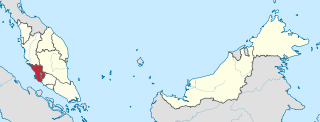
Selangor, also known by its Arabic honorific Darul Ehsan, or "Abode of Sincerity", is one of the 13 states of Malaysia. It is on the west coast of Peninsular Malaysia and is bordered by Perak to the north, Pahang to the east, Negeri Sembilan to the south and the Strait of Malacca to the west. Selangor surrounds the federal territories of Kuala Lumpur and Putrajaya, both of which were previously part of it.

Johor Bahru, colloquially referred to as JB, is the capital city of the state of Johor, Malaysia. It is located along the Straits of Johor, at the southern end of Peninsular Malaysia. The city has a population of 1,711,191 people within an area of 220 km2. Johor Bahru is adjacent to the city of Iskandar Puteri and Pasir Gudang, together with their surrounding areas anchoring Malaysia's second largest urban agglomeration, Iskandar Malaysia, with a population of 2,500,000.

Nasi lemak is a dish originating in Malay cuisine that consists of fragrant rice cooked in coconut milk and pandan leaf. It is commonly found in Malaysia, where it is considered the national dish. It is also the native dish in neighbouring areas with significant Malay populations such as Singapore, Brunei, and Southern Thailand. In Indonesia it can be found in several parts of Sumatra, especially the Malay regions of Riau, Riau Islands and Medan. Nasi lemak can also be found in the Bangsamoro region of Mindanao, prepared by Filipino Moros, as well as Australia's external territories of Christmas Island and the Cocos (Keeling) Islands. It is considered an essential dish for a typical Malay-style breakfast. Nasi lemak is featured as a national dish in most of the country’s tourism brochures and promotional materials.

Laksa is a spicy noodle dish popular in Southeast Asia. Laksa consists of various types of noodles, most commonly thick rice noodles, with toppings such as chicken, prawn or fish. Most variations of laksa are prepared with a rich and spicy coconut soup or a broth seasoned with sour asam.

Kota Bharu, colloquially referred to as KB, is a town in Malaysia that serves as the state capital and royal seat of Kelantan. It is situated in the northeastern part of Peninsular Malaysia and lies near the mouth of the Kelantan River.

Malay cuisine is the traditional food of the ethnic Malays of Southeast Asia, residing in modern-day Malaysia, Indonesia, Singapore, Brunei, Southern Thailand and the Philippines as well as Cocos Islands, Christmas Island, Sri Lanka and South Africa.
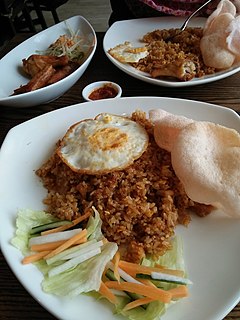
Nasi goreng is a Southeast Asian fried rice dish, usually cooked with pieces of meat and vegetables. One of Indonesia's national dishes, it is also endemic in Malay-speaking communities in countries such as Malaysia, Singapore and Brunei, and has gained popularity in Sri Lanka through migrations from the Malay Archipelago, in countries like Suriname via Indonesian immigrant communities, and in the Netherlands through its colonial ties with Indonesia. Nasi goreng is distinguished from other Asian fried rice preparations by its distinct smoky aroma, and caramelised yet savoury undertones of flavour. There is no single defined recipe for nasi goreng, and its composition and preparation varies greatly from household to household.

Nasi dagang is a Malaysian dish consisting of rice steamed in coconut milk, fish curry and extra ingredients such as pickled cucumber and carrots.

Sultan Ibrahim ibni Almarhum Sultan Iskandar is the 25th Sultan of Johor and the 5th Sultan of modern Johor, since January 2010. He is the son of Sultan Iskandar. A motorcycle enthusiast, Sultan Ibrahim is the founder of the annual motorcycling tour event, Kembara Mahkota Johor.
The flag and the coat of arms of Johor are state symbols of Johor, Malaysia. Like other states of Malaysia with Malay royalties, the state symbols of Johor are influenced by Johor's royalties, as well as Islam and the political and natural features of the state.

Majlis Perbandaran Muar Football Club or commonly known MP Muar FC was a Malaysian football club based in Muar, Johor. The club home ground was the Sultan Ibrahim Mini Stadium in Muar. The club had formerly played in the Malaysian League's second division as well as second-tier professional Malaysia Premier League for three consecutive 2010, 2011 and 2012 seasons; before the new direction of Johor Football Association (JFA) for all clubs from Johor including MP Muar FC to pull out from the Malaysia Premier League at the end of 2012 season to join State League, the PBNJ State League only.

The Royal Johor Military Force is an independent military force of the state of Johor and the private royal guard of Sultan of Johor in Malaysia. The JMF is Malaysia’s oldest active military unit still in operation and the only military in the Federation that is maintained by a state. The force comes under the control of the Sultan. Its headquarters are located at Sultan Ibrahim Camp, Johor Bahru.

Johor, also spelled as Johore, is a state of Malaysia in the south of the Malay Peninsula. Johor has land borders with the Malaysian states of Pahang to the north and Malacca and Negeri Sembilan to the northwest. Johor shares maritime borders with Singapore to the south and Indonesia to both the west and east. Johor Bahru is the capital city and the economic centre of the state, Kota Iskandar is the seat of the state government, and Muar serves as the royal town of the state. The old state capital is Johor Lama. As of 2020, the state's population is 4.01 million. Johor has highly diverse tropical rainforests and an equatorial climate. The state's mountain ranges form part of the Titiwangsa Range, which is part of the larger Tenasserim Range connected to Thailand and Myanmar, with Mount Ophir being the highest point in Johor.

Raja Zarith Sofiah binti Almarhum Sultan Idris Iskandar Al-Mutawakkil Alallahi Shah Afifullah is the Permaisuri of Johor. She was born as a member of the Perak Royal Family. While still attending Somerville College, Oxford, she married the heir to the throne of Johor. Now a mother of six, she participates in the work of non-governmental organisations and universities, and writes a periodical column for a newspaper.
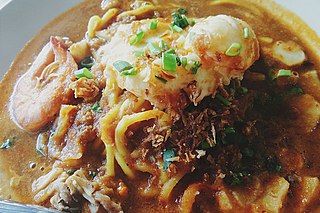
Mee Bandung Muar, or simply mee bandung, is a traditional Malaysian cuisine which is originated in Muar, Johor, Malaysia.
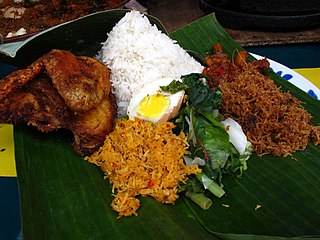
Nasi ambeng or Nasi ambang is an Indonesian fragrant rice dish that consists of - but is not limited to - steamed white rice, chicken curry or chicken stewed in soy sauce, beef or chicken rendang, sambal goreng urap, bergedel, and serunding.

Sarawakian cuisine is a regional cuisine of Malaysia. Like the rest of Malaysian cuisine, Sarawak food is based on staples such as rice. There is also a great variety of other ingredients and food preparations due to the influence of the state's varied geography and indigenous cultures quite distinct from the regional cuisines of the Peninsular Malaysia. Sarawak is famous for its multi-ethnic population. As the homeland of many unique communities, Sarawak has a variety of cuisines rarely found elsewhere in Malaysia. The uniqueness of Sarawak well depends on its ethnic groups. Every native group in Sarawak has their own lifestyle, traditions, cultures and also foods. Sarawak cuisine is less spicy and has a subtle in taste. It uses fresh seafood and natural herbs like turmeric, lemongrass, ginger, lime and tapioca leaves. These ingredients are not only easily available, but also add a hint of aroma, texture and freshness to the delicacies. Food is one of the most cultural identities for native groups in Sarawak with each ethnic group having their own delicacies. Among the Iban, popular foods include tubu (stems), tuak and pansuh. The Malay have bubur pedas (porridge) and kek lapis Sarawak ; the Bidayuh have asam siok and sup ponas Bidayuh. The Melanau make tebaloi, sagu and umai and the Orang Ulu are known for garam barrio, kikid (broth), tengayen, and urum giruq (pudding).

Dato' Haji Osman bin Sapian was a Malaysian politician who served as the 16th Menteri Besar of Johor from May 2018 to his resignation in April 2019. He served as Member of the Johor State Legislative Assembly (MLA) for Kempas twice from November 1999 to May 2013 and from May 2018 to his death in December 2021. He was a member of the Malaysian United Indigenous Party (BERSATU), a component party of the ruling Perikatan Nasional (PN) coalition.
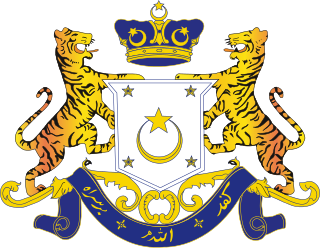
Yang Amat Mulia Che' Puan Besar Khaleeda binti Bustamam is the wife of Tunku Ismail Idris. Through her marriage she is known as the Consort of the Crown Prince of the Malaysian State of Johor.

Nasi Lemuni is a rice dish originating from Malaysia. It's traditionally eaten as a confinement dish as it is believed that vitex trifolia, the herb, can enhance blood flow, balance hormones, and improve one's digestion. It's similar to nasi lemak but it's cooked with an herb known as daun lemuni.



















